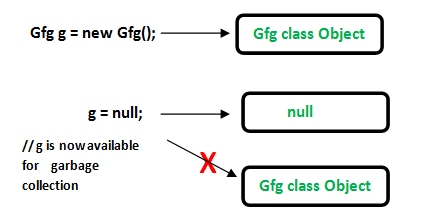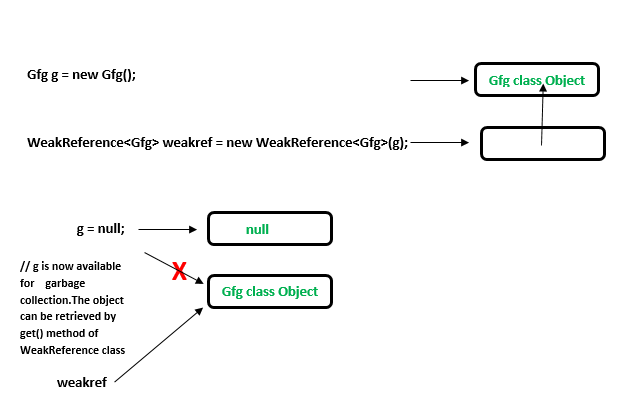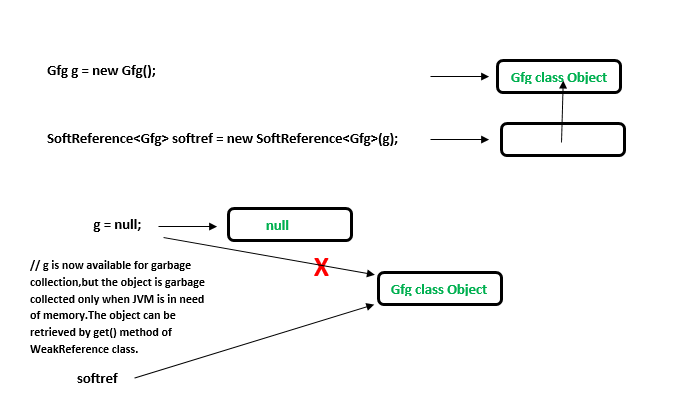更新时间:2022-08-25 09:51:22 来源:动力节点 浏览599次
在 Java 中,有四种类型的引用在它们被垃圾收集的方式上有所不同。
强引用
弱引用
软引用
幻影引用
先决条件:垃圾收集
这是引用对象的默认类型/类。任何具有活动强引用的对象都没有资格进行垃圾回收。只有当被强引用的变量指向 null 时,对象才会被垃圾回收。
MyClass obj = new MyClass();
这里的 'obj' 对象是对新创建的 MyClass 实例的强引用,当前 obj 是活动对象,因此不能被垃圾收集。
对象=空;
//'obj' 对象不再引用实例。
所以'MyClass 类型对象现在可用于垃圾收集。

// Java program to illustrate Strong reference
class Gfg
{
//Code..
}
public class Example
{
public static void main(String[] args)
{
//Strong Reference - by default
Gfg g = new Gfg();
//Now, object to which 'g' was pointing earlier is
//eligible for garbage collection.
g = null;
}
}
弱引用对象不是引用对象的默认类型/类,在使用它们时应明确指定。
这种类型的引用在 WeakHashMap 中用于引用条目对象。
如果 JVM 检测到一个只有弱引用的对象(即没有强或软引用链接到任何对象对象),该对象将被标记为垃圾回收。
要创建此类引用,使用java.lang.ref.WeakReference类。
这些引用在实时应用程序中使用,同时建立一个 DBConnection,当使用数据库的应用程序关闭时,垃圾收集器可能会清理该 DBConnection。

//Java Code to illustrate Weak reference
import java.lang.ref.WeakReference;
class Gfg
{
//code
public void x()
{
System.out.println("GeeksforGeeks");
}
}
public class Example
{
public static void main(String[] args)
{
// Strong Reference
Gfg g = new Gfg();
g.x();
// Creating Weak Reference to Gfg-type object to which 'g'
// is also pointing.
WeakReference<Gfg> weakref = new WeakReference<Gfg>(g);
//Now, Gfg-type object to which 'g' was pointing earlier
//is available for garbage collection.
//But, it will be garbage collected only when JVM needs memory.
g = null;
// You can retrieve back the object which
// has been weakly referenced.
// It successfully calls the method.
g = weakref.get();
g.x();
}
}
输出:
GeeksforGeeks
GeeksforGeeks
可以招募两种不同级别的弱点:软弱点和幻影弱点
在软引用中,即使对象可以进行垃圾回收,也不会被垃圾回收,直到 JVM 严重需要内存。当 JVM 内存不足时,对象会从内存中清除。创建这样的引用使用java.lang.ref.SoftReference类。

//Code to illustrate Soft reference
import java.lang.ref.SoftReference;
class Gfg
{
//code..
public void x()
{
System.out.println("GeeksforGeeks");
}
}
public class Example
{
public static void main(String[] args)
{
// Strong Reference
Gfg g = new Gfg();
g.x();
// Creating Soft Reference to Gfg-type object to which 'g'
// is also pointing.
SoftReference<Gfg> softref = new SoftReference<Gfg>(g);
// Now, Gfg-type object to which 'g' was pointing
// earlier is available for garbage collection.
g = null;
// You can retrieve back the object which
// has been weakly referenced.
// It successfully calls the method.
g = softref.get();
g.x();
}
}
输出:
GeeksforGeeks
GeeksforGeeks
幻影引用所引用的对象符合垃圾回收条件。但是,在将它们从内存中删除之前,JVM 会将它们放入一个名为 'reference queue' 的队列中。在对它们调用 finalize() 方法后将它们放入引用队列中。使用java.lang.ref.PhantomReference类创建此类引用。
//Code to illustrate Phantom reference
import java.lang.ref.*;
class Gfg
{
//code
public void x()
{
System.out.println("GeeksforGeeks");
}
}
public class Example
{
public static void main(String[] args)
{
//Strong Reference
Gfg g = new Gfg();
g.x();
//Creating reference queue
ReferenceQueue<Gfg> refQueue = new ReferenceQueue<Gfg>();
//Creating Phantom Reference to Gfg-type object to which 'g'
//is also pointing.
PhantomReference<Gfg> phantomRef = null;
phantomRef = new PhantomReference<Gfg>(g,refQueue);
//Now, Gfg-type object to which 'g' was pointing
//earlier is available for garbage collection.
//But, this object is kept in 'refQueue' before
//removing it from the memory.
g = null;
//It always returns null.
g = phantomRef.get();
//It shows NullPointerException.
g.x();
}
}
运行时错误:
线程“主”java.lang.NullPointerException 中的异常
在 Example.main(Example.java:31)
输出:
GeeksforGeeks
 Java实验班
Java实验班
0基础 0学费 15天面授
 Java就业班
Java就业班
有基础 直达就业
 Java夜校直播班
Java夜校直播班
业余时间 高薪转行
 Java在职加薪班
Java在职加薪班
工作1~3年,加薪神器
 Java架构师班
Java架构师班
工作3~5年,晋升架构
提交申请后,顾问老师会电话与您沟通安排学习